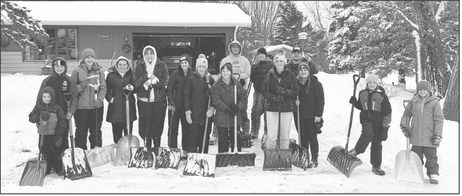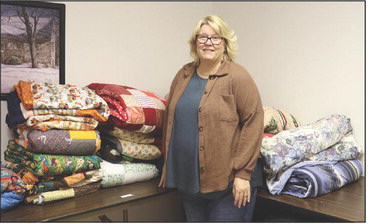County libraries request additional funding
The Clark County Library Committee is requesting greater county funding for public libraries, as committee members said the current funding formula is not adequately meeting patrons’ needs. Librarians from seven of the county’s 10 public libraries attended the county board meeting last Thursday. About 15 members of the public also came to show their support.
“Over the past few years, the library committee has requested a higher percentage reimbursement for libraries,” said Teresa Hall, Loyal Public Library director, who spoke on behalf of the librarians.
Wisconsin libraries are primarily funded by their municipality, but counties also play a key role in assuring that residents of communities that don’t have a library still have access to library services. State statute requires that counties provide a baseline level of reimbursement for services already provided for registered library users with a home address that does not have an established library.
Act 150, signed into law in 1998, established a minimum standard for county library funding. Per Wis. Stat. 43.12(1), the libraries’ cost to serve township users is found by taking the number of circulations (items checked out) to township residents multiplied by the cost per circulation. The cost per circulation is calculated by taking the total operating expenditures for a library and dividing by the total number of physical items circulated in a calendar year. Counties are required to reimburse at 70 percent of costs for township users. Clark County currently reimburses at 75 percent.
Hall explained why she felt the state funding formula was flawed and not true to the actual expenses incurred by libraries.
“Unlike funding for highways, health care facilities, law enforcement and a courthouse, county funding for libraries is a reimbursement for services in years past,” Hall explained. “The state statute formula uses the number of materials checked out, based on our cost of running the library two years ago. This method fails to consider the inflationary aspect of the current cost of operation.”
Besides failing to account for inflation, the state funding formula also fails to account for the many other services libraries provide besides loaning out materials. In 2022, Clark County libraries hosted 974 programs with 17,410 people participating. Programs included computer classes, exercise classes, seminars for the aging population, the “Click for Babies” knitting campaign, crafts for kids, scavenger hunts, escape rooms, holiday events, tea parties and other social events, and concerts, to name a few.
Other library initiatives include providing book bags for new babies, online courses through Gale Courses, Wi-Fi/print/copy/scan capabilities and offering Chromebooks, iPads and hotspots for public use. The local libraries also collaborate with the Personal Development Center, Aging and Disability Resource Center, job center, health department and other local agencies to provide resources to specific populations.
Please see Libraries, page 5 Libraries,
from p. 1
Despite the limitations of the state funding formula, it is what libraries have to work with to receive assurance of county funding. Clark County library supporters would like to see the county increase its pay-in from 70 percent of costs for township users to 100 percent. Based on last year’s numbers, this would be going from $12 per township resident to $16 per township resident.
The county gave $270,381 to the public libraries in 2022. To achieve 100 percent funding, the county would have to have given an additional $90,000, for a total contribution of $360,381. However, that $360,381 would still only constitute 0.3 percent of the county’s overall budget of $96,740,328.
Although counties are only mandated to reimburse at 70 percent, many choose to reimburse at higher rate. Of the 39 counties in the Wisconsin Valley Library Service (WVLS), 26 reimburse at 76 percent or higher, one (Clark) reimburses at 75 percent and the remaining 12 reimburse at 70 percent. Of the surrounding counties for which Hall had information, Eau Claire reimburses at 100 percent, Chippewa at 88 percent, Jackson at 85 percent and Marathon is exempt because it’s a countywide library system.
Clark County librarians and library supporters felt the 70-percent benchmark was not sufficient to cover the cost of materials and programs, and it was only appropriate for the county to chip in more because a high percentage of library users live in the townships. Thirty-eight percent of Clark County residents possess a library card. Of the library card holders, 56 percent live in a township that does not have a library. Also, 53 percent of checkouts are by township residents.
Last year, 57 percent of the libraries’ financial support came from the villages and cities, while 43 percent came from the county. This is despite the fact that two-thirds of county residents live in the townships.
As another way to look at it, last year, village/city support of libraries was, on average, $49 per resident while county support of libraries was $12 per township resident. The townships themselves may also choose to contribute to the closest library; however, the amount varies and it is typically not a large percentage of the library’s overall annual budget. For example, the Loyal Public Library receives donations from the towns of Beaver, Loyal and York each year, with the amount from each ranging between $100 and $1,500.
This is not the first time the public libraries have attempted to procure more funding. Hall said she knew the library board had given a formal presentation requesting additional funding in 2017, but nothing came of it.
County supervisors did not have a lot to say on last week’s presentation, although Supervisor Tom Wilcox had a question.
“So, you gave an analogy of how you couldn’t go into any restaurant in Clark County and pay just $7 for a $10 meal, and how that was like the 70-percent funding formula. So my question is, how are you making up that 30-percent shortfall?” he asked Hall.
“Well, we have to pinch pennies. We share things with other libraries and use WVLS items like the MakerSpace kits, instead of having our own items. Usually it’s materials we end up cutting,” said Hall.
“It slices my book budget,” said Granton Public Library Director Kay Heiting. “Or it may be laying off a part-time staff member.”
Wilcox reiterated the question, asking for more specifics.
“So, for example, James Patterson is a popular author. He comes out with a new book every month. So I can’t afford to buy the new ones for people. For me, where I cut my spending was in materials — books, audiobooks and movies,” said Hall.
Supervisor Allen Krause also had a comment. He said that Hall had referenced sharing resources with other libraries, and that if the county board were to approve more funding, he would want to see the libraries continue sharing resources just as much as they did before. The librarians assured him that would continue.
Supervisor Arlene Kool spoke of the importance of libraries.
“If you have slow internet, the library is the best place to go. I see a lot of people go there just for that purpose,” she said.
Supervisor Roy Tyznik agreed. Bryce Luchterhand also chimed in. He is a former county supervisor and current member of the library committee.
“You asked about how they make up 30 percent — I think these ladies are being very modest in answering that question. They host a lot of fundraisers throughout the year to try and make that up. And they go above and beyond the regular hours they get paid for,” he said.
The county board did not take any action on library funding, as it was listed on the agenda only as a presentation. If the board were to approve additional funding, that would happen during budget time. The budget will be presented to the finance committee in August, the executive committee in September and the full county board in October.
The librarians plan to attend future board meetings leading up to the budget process. The next county board meeting will be July 20 at 7 p.m.
Additional stats: County libraries by the numbers In 2022, there were 13,615 registered library users in Clark County. There were also: — 69,607 visits to libraries — 212,025 physical items borrowed — 30,425 participants in 1,343 in-person or self-directed programs — 36,226 public computer or free Wi-Fi users — 31,480 website visits — 22,988 digital items checked out In 2022, the average library user: visited a library five times, checked out 16 physical items, downloaded two ebooks or audiobooks, used a public computer or logged into Wi-Fi three times, and participated in in-person programs or self-directed activities two times.



